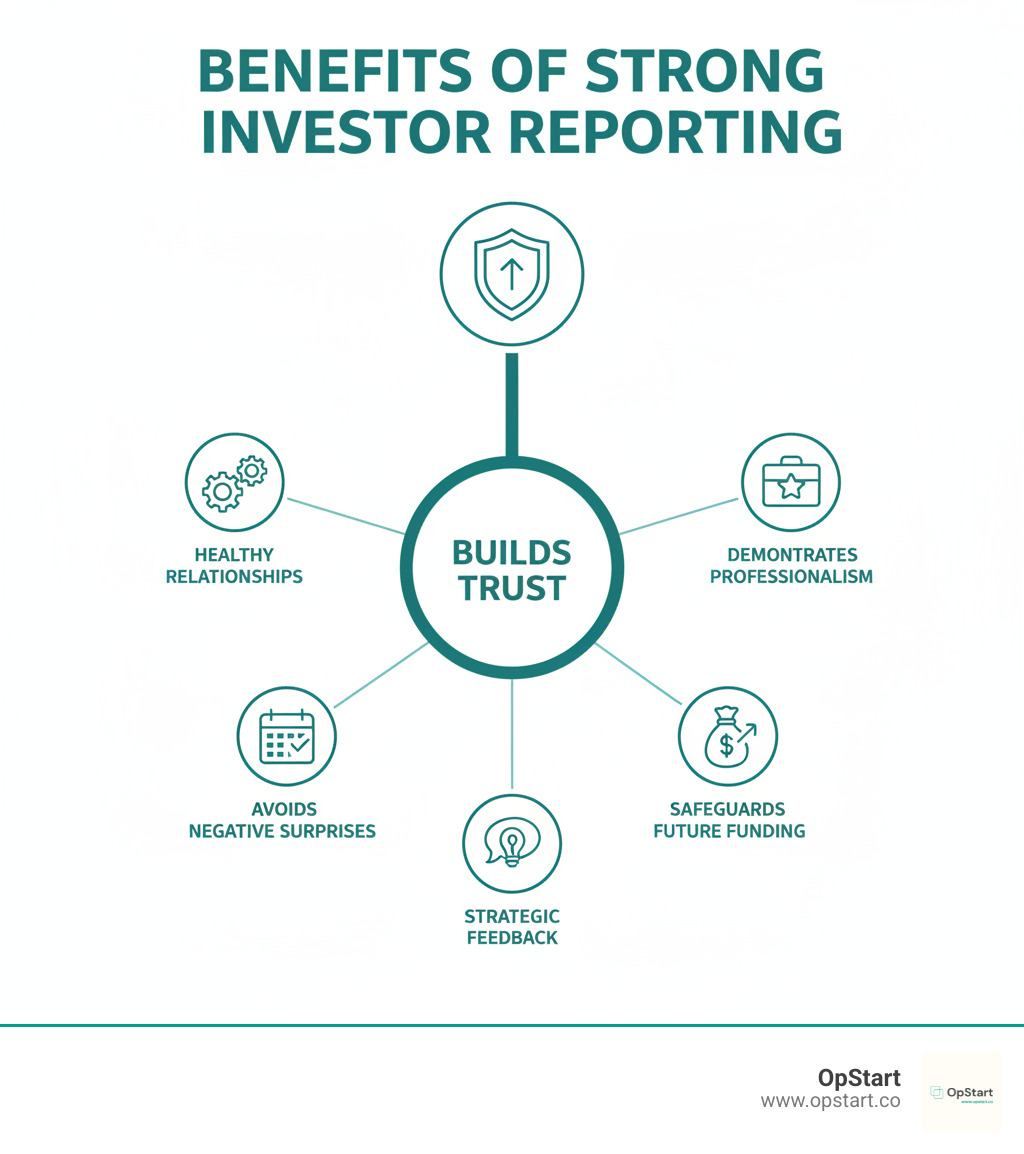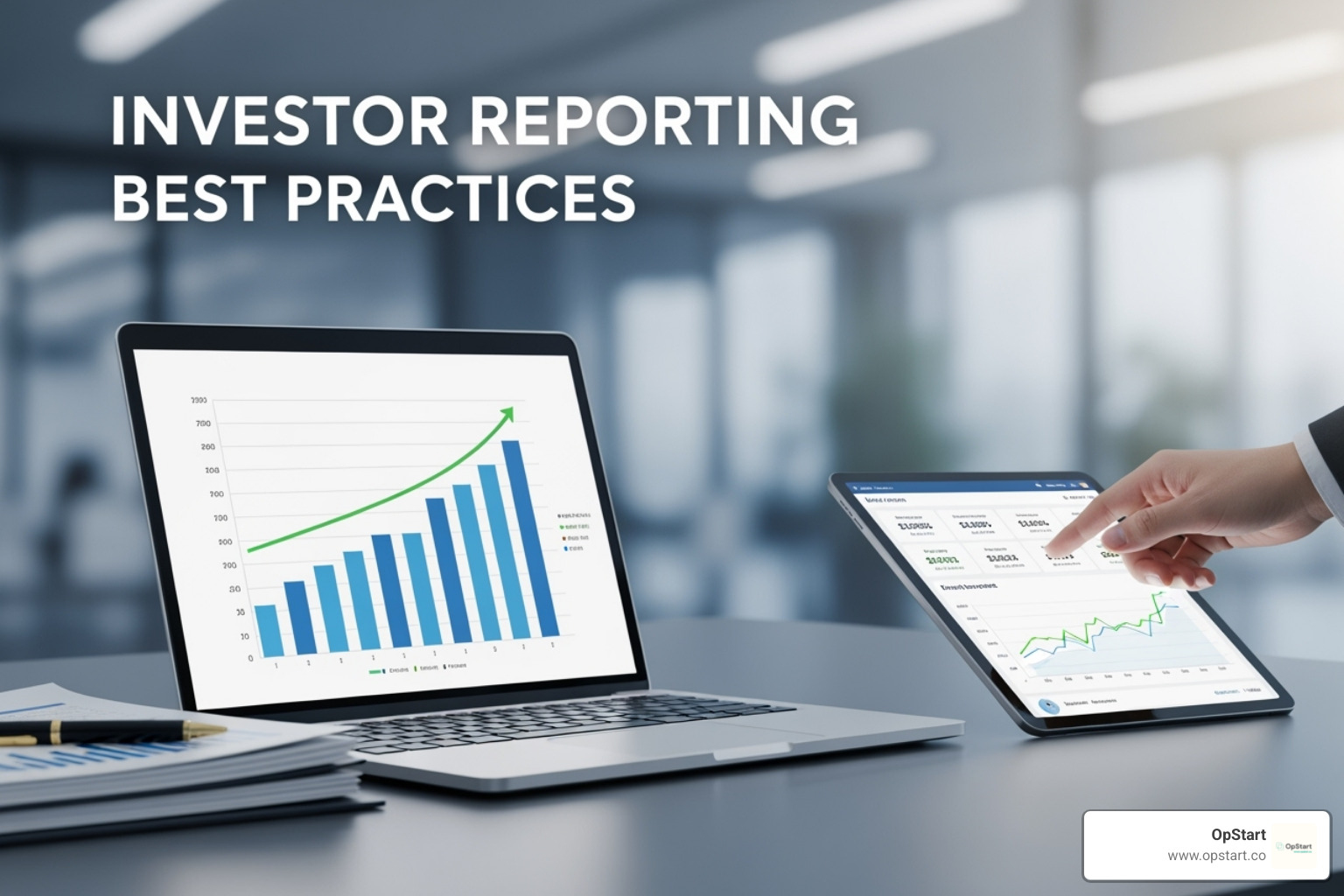Why Investor Reporting is Your Startup’s Secret Weapon
Investor reporting best practices are more than compliance checkboxes—they’re your opportunity to build trust, secure future funding, and turn your investors into strategic partners. Here’s what you need to know:
- Establish a consistent cadence: Monthly for early-stage, quarterly as standard
- Focus on transparency: Report both wins and challenges honestly
- Tell a story with data: Use clear visuals and narrative structure
- Automate where possible: Consolidate data into a single source of truth
- Customize for your audience: Tailor reports to different investor types
- Include key metrics: MRR, CAC, LTV, burn rate, and cash runway
- Make it actionable: Always include clear asks and next steps
In today’s economic climate, where 54% of investors expect overall investment activity to recover by the first half of 2025, your reports are a strategic tool that can mean the difference between struggling for your next round and having investors compete to back you.
Your investors have already bet on you. Each report either reinforces their confidence or raises red flags. The startups that treat reporting as a strategic advantage—not an administrative burden—are the ones that maintain strong relationships and secure follow-on funding when they need it most.
But most founders are overwhelmed. You’re juggling product, customers, and team building. When reporting becomes rushed or inconsistent, it can damage investor confidence rather than build it.
I’m Maurina Venturelli, and I’ve built demand engines that generated 20% of total ARR for a public company and led full-stack marketing for high-growth startups. Throughout my career, I’ve seen how mastering investor reporting best practices separates companies that scale from those that stall. Now, as Head of Go-to-Market at OpStart, I help founders transform their financial reporting from a dreaded chore into a competitive advantage.

Why Robust Investor Reporting is a Startup Superpower
Investor reporting probably isn’t your favorite task, but investor reporting best practices are one of your most powerful strategic tools. In an unpredictable economic environment, the startups that thrive build unshakeable trust with their investors, turning those relationships into genuine strategic advantages.
The Core Benefits for Your Startup
Founders who shift their mindset from viewing reporting as a chore to an opportunity transform their investor relationships. Regular, transparent communication shows investors you value their partnership, not just their capital.
Surprises are rarely welcome. Proactive reporting lets you frame challenges on your terms, with context and solutions already in place. You’re not catching investors off guard; you’re bringing them along on the journey.
Your investors have a goldmine of experience and connections. Detailed updates open the door to invaluable insights, introductions, and guidance that can accelerate your growth.
When it’s time to raise your next round, consistent communication pays off. Your existing investors become your biggest advocates. For new investors, a track record of transparent reporting is a powerful signal that you’re organized, honest, and professional. For more on navigating the fundraising landscape, see our guide on Fundraising in Today’s Market.
If you’ve taken VC funding, regular reporting is typically required in your term sheet. Instead of viewing this as bureaucracy, think of it as alignment. Meeting this expectation from day one sets the tone for a professional, productive relationship.

Building and Maintaining Investor Trust
Trust is everything in the investor-founder relationship, and building it requires discipline.
Communicate proactively. Consistent updates, even when things aren’t perfect, build confidence and reduce the anxiety that comes when investors don’t hear from you.
Be honest about challenges. Explain what went wrong and outline your plan to fix it. This demonstrates maturity and strengthens credibility. Bad news doesn’t improve with age; it’s always better to control the narrative yourself.
Well-structured, accurate, and timely reports showcase your competence. They communicate that you understand your numbers and are in control of your business narrative. This attention to detail matters enormously to investors who are evaluating whether to double down in your next round. If managing these reports feels overwhelming, professional support—like our CFO Services for Startups—can make a real difference.
Investors are in it for the long haul. By consistently delivering on your reporting commitments, you transform a transactional relationship into a true partnership that provides sustained support and follow-on funding when you need it most.
The Anatomy of a World-Class Investor Report
Think of your investor report as a conversation, not a data dump. The best reports don’t just present numbers—they tell your company’s story in a way that builds confidence and keeps everyone aligned.
Essential Components of Your Report
Every strong investor report needs a backbone. Here are the essential pieces:
Start with your executive summary. If your investors only read one section, this is it. Include key metrics (revenue, burn rate, runway), highlight the most important wins or challenges, and give them the headline news.
Your financial statements are the heartbeat of the report. Include your income statement (P&L), balance sheet, and cash flow statement to show health, growth, and liquidity. Learn more about How to Read a P&L and How to Read a Balance Sheet.
The performance overview brings context to the numbers. Explain the story behind the results—the initiatives you launched, the obstacles you overcame, and the lessons you learned.
Product updates keep investors excited about your vision. Share what you’ve shipped, what customers are saying, and what technical challenges you’ve solved.
Company updates cover the operational side. Talk about key hires, new partnerships, and any significant changes to your team or infrastructure.
Forecasts and scenario planning demonstrate strategic thinking. Present your base case, upside, and downside scenarios to show you’re planning for multiple futures.
Close with key takeaways that reinforce your strategic direction and what investors should remember from the report.
For a head start, check out the OpStart investor report template to ensure you’re covering all essential components.
Key KPIs Investors Actually Care About
Investors want to see the numbers that indicate whether your business model works. Here are the most important ones:
Monthly Recurring Revenue (MRR) and Annual Recurring Revenue (ARR) are the gold standard for SaaS and subscription businesses, showing predictable income.
Customer Acquisition Cost (CAC) tells investors how efficiently you’re growing by revealing how much you spend to land each new customer.
Lifetime Value (LTV) shows the total revenue you expect from each customer. A healthy LTV to CAC ratio (typically 3:1 or better) signals a scalable business model.
Churn rate is critical for subscription businesses. Low churn indicates product-market fit and customer satisfaction.
Burn rate and cash runway are existential metrics. Your burn rate is your monthly cash spend, while runway tells you how many months you can operate. Regular Cash Flow Analysis helps you stay on top of these.
Gross margin reveals your fundamental profitability and gives you room to invest in growth.
For e-commerce and hardware, unit economics and profitability per unit sold often matter more. Know which metrics matter for your business model.
| KPI | SaaS / Subscription | E-commerce / Hardware |
|---|---|---|
| MRR / ARR | Monthly / Annual Recurring Revenue | Not applicable |
| CAC | Cost to acquire each customer | Cost to acquire each customer |
| LTV | Total revenue per customer over time | Total revenue per customer over time |
| Churn Rate | Rate of subscription cancellations | Repeat purchase rate is key |
| Burn Rate | Monthly cash outflow | Monthly cash outflow |
| Cash Runway | Months until cash runs out | Months until cash runs out |
| Gross Margin | Revenue minus COGS | Revenue minus COGS |
| Unit Economics | Embedded in LTV/CAC | Profitability per unit |
The Art of Storytelling with Data Visualization
Raw numbers are boring; visuals are engaging. The human brain processes images 60,000 times faster than text, so use that to your advantage.

- Clarity over complexity. A simple line graph showing revenue growth communicates more than a dense table of numbers.
- Choose the right chart. Use line graphs for trends, bar charts for comparisons, and pie charts for composition.
- Build a narrative. Start with the big picture (overall revenue) and then zoom in on the factors driving that trend (customer acquisition, deal size).
- Highlight what matters. Use color and callouts to draw attention to key trends, like a sudden drop in CAC or improving churn.
- Keep it professional. Use your brand colors and maintain consistent styling. A polished appearance reinforces that you’re running a tight ship.
The goal of investor reporting best practices is to give investors confidence that you understand your business and are making smart decisions with their capital.
A Founder’s Guide to Investor Reporting Best Practices
Let’s get practical. The startups that excel at investor reporting best practices have built systems that make reporting feel natural rather than forced.
Establishing a Proactive Culture and Consistent Cadence
Shift your mindset: investor reporting is a strategic tool for your own benefit. It forces you to evaluate your business objectively, articulate your strategy, and prepare for tough questions.
Quarterly reporting is the market standard. It shows meaningful progress without being overwhelming. Aim to send quarterly reports no later than 60 days after the quarter ends, and annual reports within 90 days.
Assign clear responsibility. Don’t let reporting be everyone’s job, or it becomes no one’s job. Designate one person to own the process, set deadlines, and ensure the report comes together on time.
Use a reporting calendar to schedule data gathering, drafts, and send dates. When reporting becomes scheduled and predictable, it stops feeling like a burden. For more insights, check out this guide on Best Practices in Investment Reporting.
One of the most crucial investor reporting best practices: Ensuring Transparency, Accuracy, and Compliance
Your investors understand that startups face challenges. The cardinal rule of investor reporting is to share both good and bad news with equal honesty.
When you report disappointing results, be straightforward: “We projected $500K in revenue this quarter but came in at $380K. Here’s why, what we learned, and how we’re adjusting.” This kind of transparency builds trust, not weakness. Bad news doesn’t improve with age.
Beyond honesty, your reports must be accurate. This means having solid internal processes for data collection and validation. Even small errors can raise questions about your operational competence.
Be aware of compliance requirements. While private startups don’t face the same public reporting obligations, standards from bodies like the Securities and Exchange Commission inform best practices. Stay current on requirements like Beneficial Ownership Information Reporting to ensure you’re meeting all your obligations.
Customizing Reports for Different Investor Needs
Not all investors care about the same things, and smart founders tailor reports accordingly.
- Venture capitalists typically want detailed financial models, operational KPIs, and clear growth projections. They need depth and precision to report to their own LPs.
- Angel investors often have a more personal connection and appreciate a narrative-driven update that helps them feel connected to your journey.
- Strategic investors care about market trends and partnerships, while financial investors are laser-focused on returns and exit potential.
The good news is you don’t need to create entirely different reports. Start with a comprehensive core report, then adjust the emphasis in your executive summary and add commentary that speaks to specific interests.
Understanding your investors’ priorities is key. If you’re still building your network, our guide on How to Find and Meet VCs can help you understand what different types of investors look for.
Leveraging Technology to Streamline and Lift Reporting
Wrestling with spreadsheets and manually compiling reports is a time-consuming nightmare. For example, one company, Alpha Alternatives, cut their report processing time by 95% by implementing automation. This isn’t just an improvement; it’s changeal.
If you’re still doing reporting manually, you’re working harder than necessary. Technology makes investor reporting best practices possible for resource-strapped startups.

The Power of Automation and Centralized Data
Your data is scattered: revenue in Stripe, customer metrics in your CRM, expenses everywhere. Reconciling it is a detective game.
Financial Planning & Analysis (FP&A) tools are a game-changer. These platforms automatically pull data from all your systems and consolidate it, turning a three-day task into a thirty-minute review.
Adopting a BizOps mindset—where finance and operations teams work from the same playbook—ensures data flows seamlessly. The magic happens when you create a single source of truth. No more discrepancies between departments; everyone works from identical, accurate information.
This data consolidation eliminates manual processes that eat your time and introduce errors. Your finance team stops being data entry clerks and starts being strategic advisors. If you’re wondering how to build this system, see our guide on Finding Your Ideal Fractional CFO Service Provider.
The Future is Now: AI, Secure Data, and Cybersecurity
The technology powering investor reporting is evolving faster than most founders realize and is available now.
AI-powered analysis is moving beyond buzzwords. Modern platforms can analyze your financial data, spot trends you might miss, and even tailor insights for specific investors.
Security is another area making huge leaps. Blockchain technology (like AWS Blockchain) can create secure, unchangeable records of financial transactions, lifting transparency to new levels.
However, with the global cost of cybercrime projected to hit $23.84 trillion by 2027, protecting investor data isn’t optional. Strong data security measures need to be baked into your reporting process from day one. This means robust passwords, enterprise-grade security software, and carefully managed access rights.
Cybersecurity isn’t just about preventing breaches—it’s about maintaining trust. One security incident can undo years of transparent reporting. The good news is that modern financial platforms come with enterprise-level security built-in, so you don’t need to be an expert to protect your investors properly.
Frequently Asked Questions about Investor Reporting
You’re not alone if you have questions about investor reporting best practices. These are the questions we hear most often from founders.
What are the most common mistakes startups make in their investor reports?
Brilliant founders often undermine investor confidence with predictable—and avoidable—reporting mistakes.
- Inconsistent reporting: When you send updates sporadically, you signal disorganization and make investors wonder what you’re hiding.
- Hiding bad news: This is perhaps the most damaging mistake. Investors know startups hit roadblocks; they can’t tolerate being blindsided.
- Overwhelming with data: Investors need insights, not a 40-page data dump. Don’t make them hunt for the key takeaways.
- Lacking a clear narrative: Your report should tell the story of your journey. Without this thread, even impressive metrics can feel meaningless.
- Using vanity metrics: Total registered users sounds great, but if 90% are inactive, it’s misleading. Focus on metrics that drive the business, like active users and revenue.
- Forgetting to include an “ask”: Your investors want to help. Don’t be shy about making specific requests for introductions, advice, or resources.
How often should a startup send investor reports?
The honest answer? It depends on your stage and your investors’ expectations.
For early-stage startups (seed or pre-seed), monthly updates often make sense, as things change rapidly. As you mature, quarterly reporting becomes the standard. It provides meaningful progress updates without creating an administrative burden.
Annual reports serve a different purpose, providing a comprehensive, big-picture view of your year. These should go out no later than 90 days after year-end.
Don’t forget ad-hoc updates for major events like closing a major customer or making a key hire. Proactive communication always beats leaving investors in the dark. The most important thing is to align with your investors’ expectations during the fundraising process.
What is the single most important section of an investor report?
If I had to choose one, it’s the Executive Summary (sometimes called the CEO Letter).
Your investors are busy. Many will read your executive summary in detail and then skim the rest. This section needs to deliver key takeaways immediately: your biggest wins, challenges, and your plan moving forward. If an investor reads nothing else, they should walk away understanding your current state.
The financial health snapshot—particularly your cash runway—absolutely must appear here. Don’t bury it on page 12.
Your executive summary should also clearly show progress against goals. Did you hit the milestones you outlined in your last report? If not, why not? Investors want to see that you track progress honestly and adapt.
Think of your executive summary as a movie trailer. It needs to grab attention, convey the essential plot points, and make people want to see the full story.
Conclusion: Turn Your Reporting into a Fundraising Asset
You understand that investor reporting best practices are more than a to-do list; they’re your opportunity to build relationships that amplify success. Every report you send is either building confidence or creating doubt. Mastering transparent, consistent, and strategic reporting demonstrates the leadership and financial discipline that makes investors eager to write their next check.
The startups that thrive communicate openly and treat their investors as partners. They understand that a well-crafted investor report is a fundraising asset in disguise. When you establish a proactive reporting culture, tell a compelling story with your data, and leverage technology, your investors shift from passive observers to active champions. They make introductions, provide guidance, and are ready to invest in your next round.
At OpStart, we know you started your company to solve a problem, not to become a financial reporting expert. Our comprehensive financial operations services handle your accounting, tax filings, and CFO support at a flat rate. We help you build the systems that make investor reporting feel effortless rather than overwhelming.
When you work with us, you’re getting a partner who helps you tell your fundraising story with the clarity and confidence that turns reporting from a dreaded obligation into your competitive advantage.
The economic landscape ahead remains uncertain, but one thing is clear: the startups that master their investor communications will be the ones that secure funding and build lasting value. You’ve learned the best practices. Now it’s time to implement them.
Ready to transform how you approach investor reporting? Download our 2025 US Fundraising Trends Report to understand what investors are prioritizing. Let’s work together to make your financial operations run smoothly, so you can focus on what you do best—building an extraordinary company.
Your next investor report could be the one that changes everything. Make it count.

